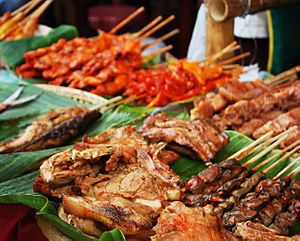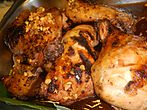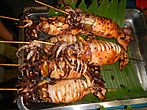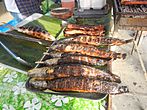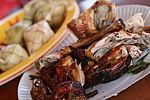Inihaw facts for kids
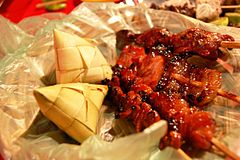 
|
|
| Alternative names | Sinugba, Inasal, Ihaw-ihaw, Sugba-suba, Filipino barbecue, Pinoy BBQ |
|---|---|
| Place of origin | Philippines |
| Similar dishes | Inasal, Lechon manok, Satti, Satay |
Inihaw (pronounced ee-NEE-how) is a super popular type of barbecue from the Philippines. You might also hear it called sinugba or inasal. It means "grilled" or "roasted" food.
Inihaw dishes are usually made from pork or chicken. They are often served on bamboo sticks, like kebabs. Sometimes, they are cut into small pieces. People usually eat Inihaw with a special dipping sauce. This sauce is often made with soy sauce and vinegar. You can also find Inihaw made with other meats or seafood. It's a common street food in the Philippines. People love to eat it with white rice or rice wrapped in coconut leaves, called pusô. Many people simply call it Filipino barbecue or Pinoy BBQ.
What is Inihaw?
The word "Inihaw" simply means "grilled" or "roasted" in the Tagalog language. It comes from the word ihaw, which means "to grill." In other parts of the Philippines, like where people speak Cebuano, it's called sinugba. In Hiligaynon, it's known as inasal. Sometimes, people just use the English word "barbecue" or "BBQ" for Inihaw on skewers.
Inihaw can be made with many different ingredients. You'll find it with pork, beef, or various kinds of seafood. Some cheaper versions even use parts of animals like intestines, called offal.
There are two main ways Inihaw is prepared:
- Direct Grilling: This is when meat or seafood is cooked right over hot charcoal. The outside gets a nice smoky, charred flavor, but the inside stays juicy. These are usually cut into cubes before you eat them. You dip them in sauces made with soy sauce (or salt) and vinegar. People often add fresh red onions, spicy chili peppers, calamansi (a small citrus fruit), fresh tomatoes, black pepper, or even a little sugar to their dipping sauce.
- Skewered Dishes: These are meats or seafood cooked and served on a stick. This can include whole roasted animals or smaller pieces of meat on skewers.
Both types of Inihaw can be marinated before cooking. Marinating means soaking the food in a flavorful sauce. They might also be basted while cooking. Basting is brushing more sauce onto the food as it cooks to keep it moist and add flavor.
The sauce used for marinating is often similar to the dipping sauce. For skewered Inihaw, a sweet sauce is common. This sauce often uses banana ketchup and annatto oil. Annatto oil gives the food a bright red or orange color. In southern Philippines, you might find a type called satti. This is served with a peanut-based sauce, much like the famous satay from other Asian countries.
In areas where Visayan languages are spoken, a popular dish is "sinuglaw." This combines grilled pork (sinugba) with kinilaw. Kinilaw is raw fish that has been "cooked" in vinegar and citrus juices.
Different Kinds of Inihaw
While Inihaw is a general term, some grilled dishes are so famous they have their own names. Here are a few:
- Lechón - This is a whole pig roasted slowly on a spit. It's usually stuffed with spices and lemongrass. It's a very special dish often served at parties.
- Chicken inasal - This is a special grilled chicken from the Western Visayas region. The chicken is marinated in a mix of calamansi, pepper, coconut vinegar, and annatto. It's grilled over hot coals and brushed with the marinade as it cooks. It's served with rice, calamansi, soy sauce, chicken oil, and a special palm vinegar.
- Lechon manok - This is a whole chicken roasted on a spit. The chicken is marinated in a mix of garlic, bay leaf, onion, black pepper, soy sauce, and patis (fish sauce). Sometimes, brown sugar is added to make it sweet. It's stuffed with lemongrass and roasted over charcoal. People usually dip it in a mix of soy sauce, calamansi, and chili peppers. It's often eaten with white rice or puso and a side of atchara (pickled papaya). You can find Lechon manok almost everywhere in the Philippines.
- Satti - These are grilled beef or chicken skewers from Mindanao. They are similar to satay dishes found in Indonesia and Malaysia. Satti is usually eaten with ta'mu (rice cooked in coconut leaves) and a bowl of warm, often peanut-based, sauce.
- Isaw - This is a very affordable type of Inihaw made from pig or chicken intestines. They are cooked and eaten just like other Inihaw. Other types of offal-based Inihaw also exist and sometimes have funny names because they look like everyday objects! For example:
Gallery
-
Inihaw na bangus (milkfish)
-
Lechon manok served with pusô
-
Inihaw na panga (tuna jaw)


